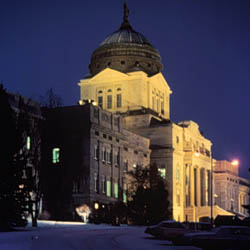Montana Government
Updated: August 10, 2020

The United States through the Louisiana Purchase acquired the territory that would become Montana in 1803. The acquisition included the region of west central North America between the Mississippi River & the Rockies, approximately 885,000 square miles (2,301,000 square kilometers), at the time an unexplored wilderness. Thomas Jefferson, exercising questionable constitutional authority, paid Napoleon Bonaparte $15 million dollars for the entire area, about three cents an acre. The sum was nearly twice the entire federal budget. Thirteen states or parts of states have been carved from the Louisiana Purchase. They are as follows: Louisiana, Arkansas, Missouri, Iowa, North Dakota, South Dakota, Nebraska, Kansas, Wyoming, Minnesota, Oklahoma, Colorado and Montana. Lewis & Clark and the Corps of Discovery conducted the first organized expedition into the area.
Montana was admitted to the Union, or became a state, on November 8, 1889, by presidential proclamation, the 41st state. Prior to becoming a state Congress made Montana a territory (a part of the U.S. not included within any state but organized with a separate legislature) in May 1864. In December the first legislative assembly met in a dirt-roofed cabin in Bannack City. Virginia City was selected as the territorial capital. Montana remained a territory for 25 years. In 1894 Helena out bid Anaconda to become the state capital, the result of a infamous battle in the "War of the Copper Kings."
The original state constitution was ratified in 1889. By 1969 the document had become outdated. Montana voters called for a constitutional convention. One hundred elected delegates met in 1972 to rewrite the document.
The Montana Legislature has 50 senators and 100 representatives elected from single-member districts. The legislature meets at regular biennial sessions for 90 days in odd-numbered years.
Montana is governed by its constitution, and its laws are administered by its executive branch officers and various boards and commissions. Executive officers include the Governor, Lieutenant Governor, Secretary of State, Attorney General, Superintendent of Public Instruction and Auditor. All were elected to four-year terms. Here is a link to The state of Montana current Montana governor.
There are 56 counties, 126 incorporated cities and towns, and two consolidated city-county governments in Montana. Nine local governments operate under the "commission-manager" form of government, including five of the state's largest cities. The majority of cities continue with the "commission-executive" form also known as the "mayor-council" form and most counties retain the traditional "commission" form.
Judicial decisions are made by a system of courts headed by the state supreme court. The court has a chief justice and six associate justices elected to eight-year terms. Nineteen district courts are each presided over by one to four judges elected to six-year terms. There are numerous municipal and justice of the peace courts. Copies of the Montana Constitution are available at no charge from the Secretary of State, State Capitol, Helena, MT 59620.
Montana has three presidential electoral votes.
Updated: August 10, 2020

